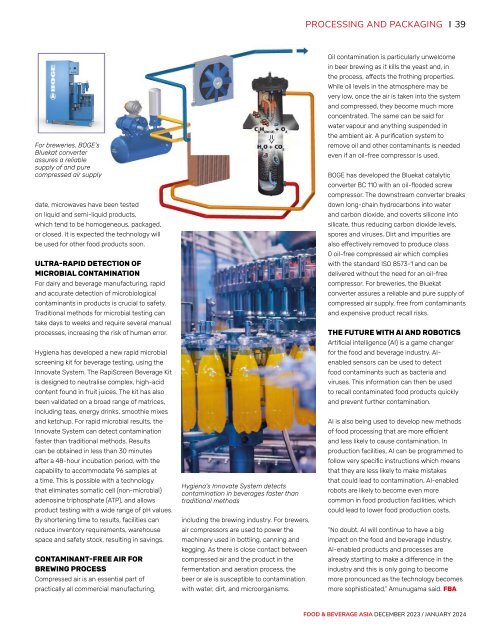Food & Beverage Asia December/January 2024
Food & Beverage Asia (FBA) is the leading source of food and beverage news in Asia since 2002. FBA delivers a comprehensive view of the food and beverage landscape, spanning across the latest health and nutrition trends and industry innovations in ingredients, recipe formulations, food science, sustainability, packaging, and automation, as well as advancements in agri and food-tech.
Food & Beverage Asia (FBA) is the leading source of food and beverage news in Asia since 2002. FBA delivers a comprehensive view of the food and beverage landscape, spanning across the latest health and nutrition trends and industry innovations in ingredients, recipe formulations, food science, sustainability, packaging, and automation, as well as advancements in agri and food-tech.
You also want an ePaper? Increase the reach of your titles
YUMPU automatically turns print PDFs into web optimized ePapers that Google loves.
PROCESSING AND PACKAGING<br />
39<br />
For breweries, BOGE’s<br />
Bluekat converter<br />
assures a reliable<br />
supply of and pure<br />
compressed air supply<br />
date, microwaves have been tested<br />
on liquid and semi-liquid products,<br />
which tend to be homogeneous, packaged,<br />
or closed. It is expected the technology will<br />
be used for other food products soon.<br />
ULTRA-RAPID DETECTION OF<br />
MICROBIAL CONTAMINATION<br />
For dairy and beverage manufacturing, rapid<br />
and accurate detection of microbiological<br />
contaminants in products is crucial to safety.<br />
Traditional methods for microbial testing can<br />
take days to weeks and require several manual<br />
processes, increasing the risk of human error.<br />
Hygiena has developed a new rapid microbial<br />
screening kit for beverage testing, using the<br />
Innovate System. The RapiScreen <strong>Beverage</strong> Kit<br />
is designed to neutralise complex, high-acid<br />
content found in fruit juices. The kit has also<br />
been validated on a broad range of matrices,<br />
including teas, energy drinks, smoothie mixes<br />
and ketchup. For rapid microbial results, the<br />
Innovate System can detect contamination<br />
faster than traditional methods. Results<br />
can be obtained in less than 30 minutes<br />
after a 48-hour incubation period, with the<br />
capability to accommodate 96 samples at<br />
a time. This is possible with a technology<br />
that eliminates somatic cell (non-microbial)<br />
adenosine triphosphate (ATP), and allows<br />
product testing with a wide range of pH values.<br />
By shortening time to results, facilities can<br />
reduce inventory requirements, warehouse<br />
space and safety stock, resulting in savings.<br />
CONTAMINANT-FREE AIR FOR<br />
BREWING PROCESS<br />
Compressed air is an essential part of<br />
practically all commercial manufacturing,<br />
Hygiena's Innovate System detects<br />
contamination in beverages faster than<br />
traditional methods<br />
including the brewing industry. For brewers,<br />
air compressors are used to power the<br />
machinery used in bottling, canning and<br />
kegging. As there is close contact between<br />
compressed air and the product in the<br />
fermentation and aeration process, the<br />
beer or ale is susceptible to contamination<br />
with water, dirt, and microorganisms.<br />
Oil contamination is particularly unwelcome<br />
in beer brewing as it kills the yeast and, in<br />
the process, affects the frothing properties.<br />
While oil levels in the atmosphere may be<br />
very low, once the air is taken into the system<br />
and compressed, they become much more<br />
concentrated. The same can be said for<br />
water vapour and anything suspended in<br />
the ambient air. A purification system to<br />
remove oil and other contaminants is needed<br />
even if an oil-free compressor is used.<br />
BOGE has developed the Bluekat catalytic<br />
converter BC 110 with an oil-flooded screw<br />
compressor. The downstream converter breaks<br />
down long-chain hydrocarbons into water<br />
and carbon dioxide, and coverts silicone into<br />
silicate, thus reducing carbon dioxide levels,<br />
spores and viruses. Dirt and impurities are<br />
also effectively removed to produce class<br />
0 oil-free compressed air which complies<br />
with the standard ISO 8573-1 and can be<br />
delivered without the need for an oil-free<br />
compressor. For breweries, the Bluekat<br />
converter assures a reliable and pure supply of<br />
compressed air supply, free from contaminants<br />
and expensive product recall risks.<br />
THE FUTURE WITH AI AND ROBOTICS<br />
Artificial intelligence (AI) is a game changer<br />
for the food and beverage industry. AIenabled<br />
sensors can be used to detect<br />
food contaminants such as bacteria and<br />
viruses. This information can then be used<br />
to recall contaminated food products quickly<br />
and prevent further contamination.<br />
AI is also being used to develop new methods<br />
of food processing that are more efficient<br />
and less likely to cause contamination. In<br />
production facilities, AI can be programmed to<br />
follow very specific instructions which means<br />
that they are less likely to make mistakes<br />
that could lead to contamination. AI-enabled<br />
robots are likely to become even more<br />
common in food production facilities, which<br />
could lead to lower food production costs.<br />
“No doubt, AI will continue to have a big<br />
impact on the food and beverage industry.<br />
AI-enabled products and processes are<br />
already starting to make a difference in the<br />
industry and this is only going to become<br />
more pronounced as the technology becomes<br />
more sophisticated,” Amunugama said. FBA<br />
FOOD & BEVERAGE ASIA DECEMBER 2023 / JANUARY <strong>2024</strong>


















